Zeyu Zhu
Paper2Video: Automatic Video Generation from Scientific Papers
Oct 06, 2025Abstract:Academic presentation videos have become an essential medium for research communication, yet producing them remains highly labor-intensive, often requiring hours of slide design, recording, and editing for a short 2 to 10 minutes video. Unlike natural video, presentation video generation involves distinctive challenges: inputs from research papers, dense multi-modal information (text, figures, tables), and the need to coordinate multiple aligned channels such as slides, subtitles, speech, and human talker. To address these challenges, we introduce PaperTalker, the first benchmark of 101 research papers paired with author-created presentation videos, slides, and speaker metadata. We further design four tailored evaluation metrics--Meta Similarity, PresentArena, PresentQuiz, and IP Memory--to measure how videos convey the paper's information to the audience. Building on this foundation, we propose PaperTalker, the first multi-agent framework for academic presentation video generation. It integrates slide generation with effective layout refinement by a novel effective tree search visual choice, cursor grounding, subtitling, speech synthesis, and talking-head rendering, while parallelizing slide-wise generation for efficiency. Experiments on Paper2Video demonstrate that the presentation videos produced by our approach are more faithful and informative than existing baselines, establishing a practical step toward automated and ready-to-use academic video generation. Our dataset, agent, and code are available at https://github.com/showlab/Paper2Video.
Automated Movie Generation via Multi-Agent CoT Planning
Mar 10, 2025



Abstract:Existing long-form video generation frameworks lack automated planning, requiring manual input for storylines, scenes, cinematography, and character interactions, resulting in high costs and inefficiencies. To address these challenges, we present MovieAgent, an automated movie generation via multi-agent Chain of Thought (CoT) planning. MovieAgent offers two key advantages: 1) We firstly explore and define the paradigm of automated movie/long-video generation. Given a script and character bank, our MovieAgent can generates multi-scene, multi-shot long-form videos with a coherent narrative, while ensuring character consistency, synchronized subtitles, and stable audio throughout the film. 2) MovieAgent introduces a hierarchical CoT-based reasoning process to automatically structure scenes, camera settings, and cinematography, significantly reducing human effort. By employing multiple LLM agents to simulate the roles of a director, screenwriter, storyboard artist, and location manager, MovieAgent streamlines the production pipeline. Experiments demonstrate that MovieAgent achieves new state-of-the-art results in script faithfulness, character consistency, and narrative coherence. Our hierarchical framework takes a step forward and provides new insights into fully automated movie generation. The code and project website are available at: https://github.com/showlab/MovieAgent and https://weijiawu.github.io/MovieAgent.
MovieBench: A Hierarchical Movie Level Dataset for Long Video Generation
Nov 22, 2024



Abstract:Recent advancements in video generation models, like Stable Video Diffusion, show promising results, but primarily focus on short, single-scene videos. These models struggle with generating long videos that involve multiple scenes, coherent narratives, and consistent characters. Furthermore, there is no publicly available dataset tailored for the analysis, evaluation, and training of long video generation models. In this paper, we present MovieBench: A Hierarchical Movie-Level Dataset for Long Video Generation, which addresses these challenges by providing unique contributions: (1) movie-length videos featuring rich, coherent storylines and multi-scene narratives, (2) consistency of character appearance and audio across scenes, and (3) hierarchical data structure contains high-level movie information and detailed shot-level descriptions. Experiments demonstrate that MovieBench brings some new insights and challenges, such as maintaining character ID consistency across multiple scenes for various characters. The dataset will be public and continuously maintained, aiming to advance the field of long video generation. Data can be found at: https://weijiawu.github.io/MovieBench/.
TernaryLLM: Ternarized Large Language Model
Jun 11, 2024



Abstract:Large language models (LLMs) have achieved remarkable performance on Natural Language Processing (NLP) tasks, but they are hindered by high computational costs and memory requirements. Ternarization, an extreme form of quantization, offers a solution by reducing memory usage and enabling energy-efficient floating-point additions. However, applying ternarization to LLMs faces challenges stemming from outliers in both weights and activations. In this work, observing asymmetric outliers and non-zero means in weights, we introduce Dual Learnable Ternarization (DLT), which enables both scales and shifts to be learnable. We also propose Outlier-Friendly Feature Knowledge Distillation (OFF) to recover the information lost in extremely low-bit quantization. The proposed OFF can incorporate semantic information and is insensitive to outliers. At the core of OFF is maximizing the mutual information between features in ternarized and floating-point models using cosine similarity. Extensive experiments demonstrate that our TernaryLLM surpasses previous low-bit quantization methods on the standard text generation and zero-shot benchmarks for different LLM families. Specifically, for one of the most powerful open-source models, LLaMA-3, our approach (W1.58A16) outperforms the previous state-of-the-art method (W2A16) by 5.8 in terms of perplexity on C4 and by 8.2% in terms of average accuracy on zero-shot tasks.
MEGA: A Memory-Efficient GNN Accelerator Exploiting Degree-Aware Mixed-Precision Quantization
Nov 16, 2023



Abstract:Graph Neural Networks (GNNs) are becoming a promising technique in various domains due to their excellent capabilities in modeling non-Euclidean data. Although a spectrum of accelerators has been proposed to accelerate the inference of GNNs, our analysis demonstrates that the latency and energy consumption induced by DRAM access still significantly impedes the improvement of performance and energy efficiency. To address this issue, we propose a Memory-Efficient GNN Accelerator (MEGA) through algorithm and hardware co-design in this work. Specifically, at the algorithm level, through an in-depth analysis of the node property, we observe that the data-independent quantization in previous works is not optimal in terms of accuracy and memory efficiency. This motivates us to propose the Degree-Aware mixed-precision quantization method, in which a proper bitwidth is learned and allocated to a node according to its in-degree to compress GNNs as much as possible while maintaining accuracy. At the hardware level, we employ a heterogeneous architecture design in which the aggregation and combination phases are implemented separately with different dataflows. In order to boost the performance and energy efficiency, we also present an Adaptive-Package format to alleviate the storage overhead caused by the fine-grained bitwidth and diverse sparsity, and a Condense-Edge scheduling method to enhance the data locality and further alleviate the access irregularity induced by the extremely sparse adjacency matrix in the graph. We implement our MEGA accelerator in a 28nm technology node. Extensive experiments demonstrate that MEGA can achieve an average speedup of 38.3x, 7.1x, 4.0x, 3.6x and 47.6x, 7.2x, 5.4x, 4.5x energy savings over four state-of-the-art GNN accelerators, HyGCN, GCNAX, GROW, and SGCN, respectively, while retaining task accuracy.
Spiking NeRF: Making Bio-inspired Neural Networks See through the Real World
Sep 20, 2023



Abstract:Spiking neuron networks (SNNs) have been thriving on numerous tasks to leverage their promising energy efficiency and exploit their potentialities as biologically plausible intelligence. Meanwhile, the Neural Radiance Fields (NeRF) render high-quality 3D scenes with massive energy consumption, and few works delve into the energy-saving solution with a bio-inspired approach. In this paper, we propose spiking NeRF (SpikingNeRF), which aligns the radiance ray with the temporal dimension of SNN, to naturally accommodate the SNN to the reconstruction of Radiance Fields. Thus, the computation turns into a spike-based, multiplication-free manner, reducing the energy consumption. In SpikingNeRF, each sampled point on the ray is matched onto a particular time step, and represented in a hybrid manner where the voxel grids are maintained as well. Based on the voxel grids, sampled points are determined whether to be masked for better training and inference. However, this operation also incurs irregular temporal length. We propose the temporal condensing-and-padding (TCP) strategy to tackle the masked samples to maintain regular temporal length, i.e., regular tensors, for hardware-friendly computation. Extensive experiments on a variety of datasets demonstrate that our method reduces the $76.74\%$ energy consumption on average and obtains comparable synthesis quality with the ANN baseline.
Unsupervised Pansharpening via Low-rank Diffusion Model
May 18, 2023



Abstract:Pansharpening is a process of merging a highresolution panchromatic (PAN) image and a low-resolution multispectral (LRMS) image to create a single high-resolution multispectral (HRMS) image. Most of the existing deep learningbased pansharpening methods have poor generalization ability and the traditional model-based pansharpening methods need careful manual exploration for the image structure prior. To alleviate these issues, this paper proposes an unsupervised pansharpening method by combining the diffusion model with the low-rank matrix factorization technique. Specifically, we assume that the HRMS image is decomposed into the product of two low-rank tensors, i.e., the base tensor and the coefficient matrix. The base tensor lies on the image field and has low spectral dimension, we can thus conveniently utilize a pre-trained remote sensing diffusion model to capture its image structures. Additionally, we derive a simple yet quite effective way to preestimate the coefficient matrix from the observed LRMS image, which preserves the spectral information of the HRMS. Extensive experimental results on some benchmark datasets demonstrate that our proposed method performs better than traditional model-based approaches and has better generalization ability than deep learning-based techniques. The code is released in https://github.com/xyrui/PLRDiff.
$\rm A^2Q$: Aggregation-Aware Quantization for Graph Neural Networks
Feb 01, 2023



Abstract:As graph data size increases, the vast latency and memory consumption during inference pose a significant challenge to the real-world deployment of Graph Neural Networks (GNNs). While quantization is a powerful approach to reducing GNNs complexity, most previous works on GNNs quantization fail to exploit the unique characteristics of GNNs, suffering from severe accuracy degradation. Through an in-depth analysis of the topology of GNNs, we observe that the topology of the graph leads to significant differences between nodes, and most of the nodes in a graph appear to have a small aggregation value. Motivated by this, in this paper, we propose the Aggregation-Aware mixed-precision Quantization ($\rm A^2Q$) for GNNs, where an appropriate bitwidth is automatically learned and assigned to each node in the graph. To mitigate the vanishing gradient problem caused by sparse connections between nodes, we propose a Local Gradient method to serve the quantization error of the node features as the supervision during training. We also develop a Nearest Neighbor Strategy to deal with the generalization on unseen graphs. Extensive experiments on eight public node-level and graph-level datasets demonstrate the generality and robustness of our proposed method. Compared to the FP32 models, our method can achieve up to a 18.6x (i.e., 1.70bit) compression ratio with negligible accuracy degradation. Morever, compared to the state-of-the-art quantization method, our method can achieve up to 11.4\% and 9.5\% accuracy improvements on the node-level and graph-level tasks, respectively, and up to 2x speedup on a dedicated hardware accelerator.
Multi-Task Conditional Imitation Learning for Autonomous Navigation at Crowded Intersections
Feb 21, 2022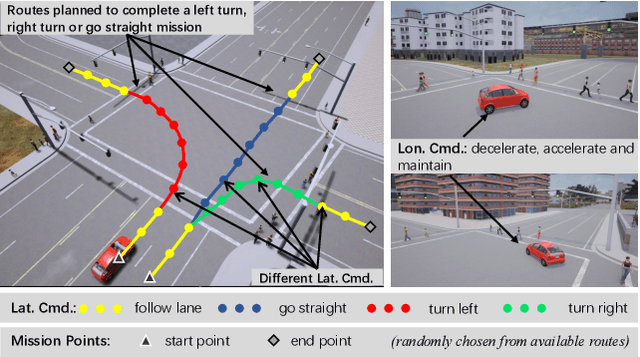
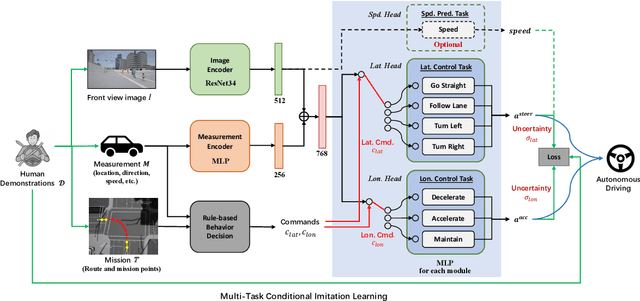
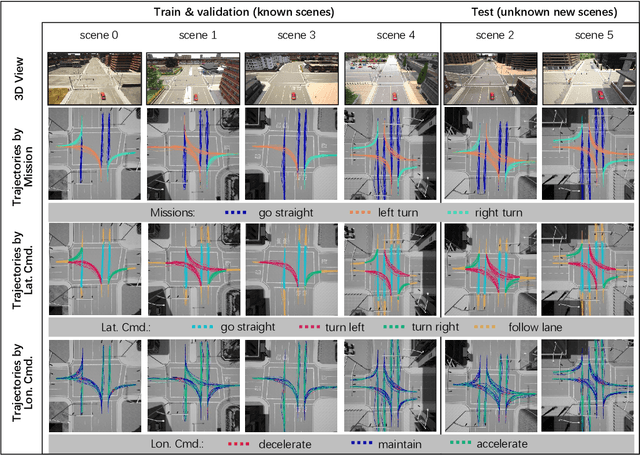
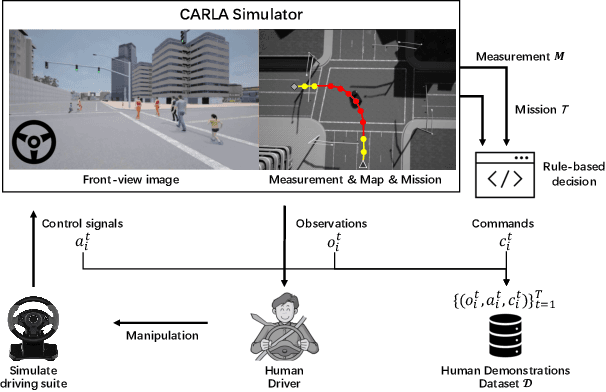
Abstract:In recent years, great efforts have been devoted to deep imitation learning for autonomous driving control, where raw sensory inputs are directly mapped to control actions. However, navigating through densely populated intersections remains a challenging task due to uncertainty caused by uncertain traffic participants. We focus on autonomous navigation at crowded intersections that require interaction with pedestrians. A multi-task conditional imitation learning framework is proposed to adapt both lateral and longitudinal control tasks for safe and efficient interaction. A new benchmark called IntersectNav is developed and human demonstrations are provided. Empirical results show that the proposed method can achieve a success rate gain of up to 30% compared to the state-of-the-art.
A Survey of Deep RL and IL for Autonomous Driving Policy Learning
Jan 06, 2021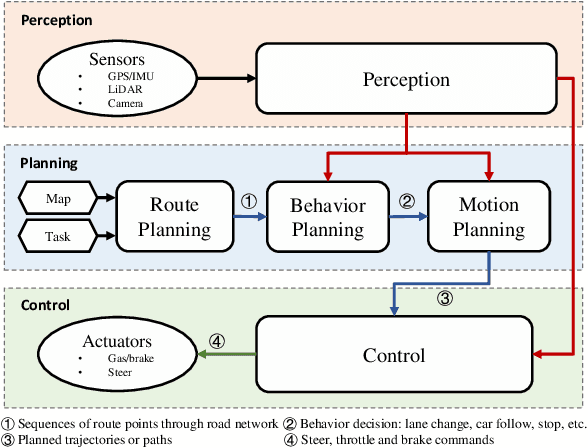

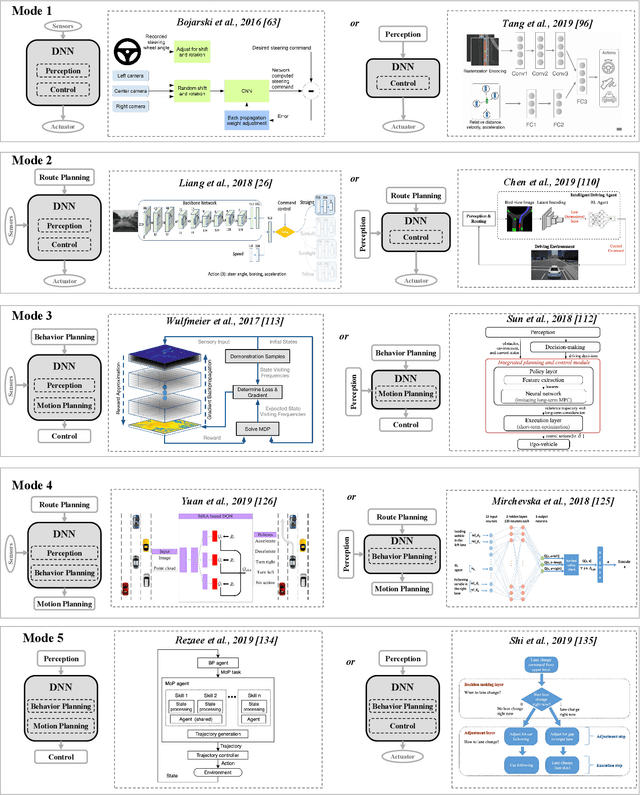
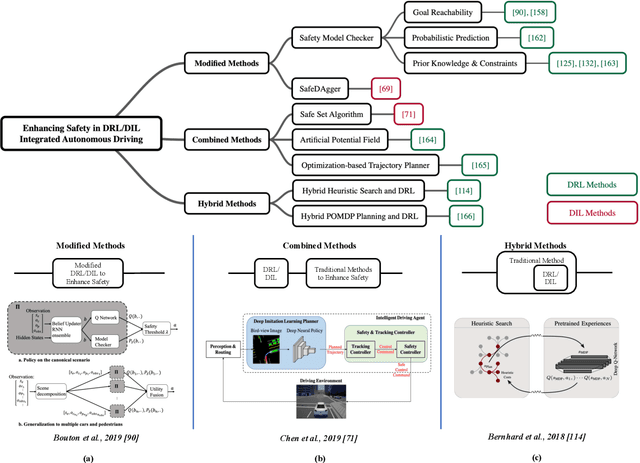
Abstract:Autonomous driving (AD) agents generate driving policies based on online perception results, which are obtained at multiple levels of abstraction, e.g., behavior planning, motion planning and control. Driving policies are crucial to the realization of safe, efficient and harmonious driving behaviors, where AD agents still face substantial challenges in complex scenarios. Due to their successful application in fields such as robotics and video games, the use of deep reinforcement learning (DRL) and deep imitation learning (DIL) techniques to derive AD policies have witnessed vast research efforts in recent years. This paper is a comprehensive survey of this body of work, which is conducted at three levels: First, a taxonomy of the literature studies is constructed from the system perspective, among which five modes of integration of DRL/DIL models into an AD architecture are identified. Second, the formulations of DRL/DIL models for conducting specified AD tasks are comprehensively reviewed, where various designs on the model state and action spaces and the reinforcement learning rewards are covered. Finally, an in-depth review is conducted on how the critical issues of AD applications regarding driving safety, interaction with other traffic participants and uncertainty of the environment are addressed by the DRL/DIL models. To the best of our knowledge, this is the first survey to focus on AD policy learning using DRL/DIL, which is addressed simultaneously from the system, task-driven and problem-driven perspectives. We share and discuss findings, which may lead to the investigation of various topics in the future.
 Add to Chrome
Add to Chrome Add to Firefox
Add to Firefox Add to Edge
Add to Edge